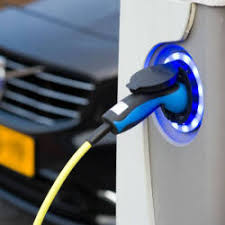Evaluating Japan’s 30,000+ Electric Vehicle (EV) Charging Stations: Public vs. Private Infrastructure

Strong 8k brings an ultra-HD IPTV experience to your living room and your pocket.
Introduction:
As the world accelerates its transition towards Electric Vehicle (EV), Japan is taking significant strides in establishing a comprehensive EV charging infrastructure. With more than 30,000 charging stations deployed across the country, Japan has become one of the leaders in the global EV market. A key aspect of this transition is the availability and accessibility of EV charging stations, which is largely determined by the balance between public and private sector investments.
Download FREE Sample of Electric Vehicle Market: https://www.nextmsc.com/electric-vehicle-market/request-sample
In this article, we will evaluate Japan's 30,000+ electric vehicle charging stations based on various parameters. One of the primary focuses will be on understanding how Japan's public and private EV charging infrastructure compare, including factors like availability, accessibility, cost, and technological innovations. By examining these parameters, we aim to gain a clearer picture of how Japan’s EV charging network is evolving to meet the demands of an expanding electric vehicle market.
1. Overview of Japan’s EV Charging Infrastructure
Japan’s EV infrastructure is the backbone of its strategy to transition towards cleaner and more sustainable transportation. With ambitious goals set by the government to achieve carbon neutrality by 2050, a widespread EV charging network is crucial for achieving these targets. The country’s 30,000+ charging stations offer a mix of Level 2 (standard) and DC fast-charging stations that cater to electric vehicle owners, helping ensure seamless adoption of EV technology.
Charging stations in Japan are operated by both public and private entities, providing a robust, flexible, and accessible network. The infrastructure is primarily concentrated in urban centers, including Tokyo, Osaka, and Kyoto, but efforts are being made to expand it to rural areas and highways to support long-distance EV travel.
2. The Role of Public EV Charging Stations in Japan
Public EV charging stations in Japan are mainly operated by government bodies, municipalities, and public-private partnerships. These stations are designed to be accessible to the general public, and they are often located in strategic areas where large numbers of people can benefit from them.
Availability and Location
Public EV charging stations are typically found in public spaces such as government buildings, shopping malls, parking lots, train stations, and high-traffic areas. The goal is to provide widespread coverage, particularly in urban areas, where most EV owners live. Given the need for a reliable and comprehensive charging infrastructure to support growing EV adoption, the government has heavily invested in expanding this network, especially in cities and along major highways.
Cost and Accessibility
Public charging stations in Japan are often subsidized or funded through government incentives, making them more affordable for consumers. Some stations are entirely free to use, while others charge a small fee based on usage or time spent charging. Charging fees are generally regulated to keep them competitive and encourage widespread usage.
The accessibility of public EV charging stations is also a key benefit. Many of these stations can be accessed by anyone, whether they are private vehicle owners or visitors. Additionally, many public charging stations support multiple EV brands, allowing various electric car owners to benefit from the infrastructure.
Download FREE Sample of Electric Vehicle Charging Market: https://www.nextmsc.com/electric-vehicle-charging-market/request-sample
Government Support and Incentives
The Japanese government plays a critical role in supporting the public EV charging network. In addition to providing funding for the installation of new charging stations, the government offers a range of incentives and subsidies for local municipalities and businesses to install public EV charging points. This has led to a rapid increase in the number of charging stations across the country.
The government's focus on developing a nationwide network of public chargers reflects the commitment to making EV ownership more convenient and accessible for the average consumer, thereby accelerating the shift toward electric vehicles.
3. The Role of Private EV Charging Stations in Japan
In contrast to public charging stations, private EV charging stations are operated by businesses, energy companies, and corporations. These stations are generally located in places such as corporate offices, residential complexes, gas stations, and retail spaces.
Business Incentives for Private Charging Stations
Private companies in Japan are rapidly expanding their charging infrastructure to meet the demand for EV charging solutions. Major corporations like Toyota, Nissan, and Panasonic, as well as utilities and energy companies, have made significant investments in the EV charging sector.
One of the driving forces behind the growth of private charging stations is the potential for businesses to create new revenue streams by offering charging services. For example, large retailers and shopping malls are installing EV charging stations to attract customers who own electric vehicles, encouraging them to visit their stores and spend time on their premises while charging.
Charging Speed and Technological Innovation
Private charging stations are often at the forefront of technological advancements in the EV sector. Many private operators are investing in ultra-fast charging solutions that can charge vehicles at much higher speeds compared to traditional Level 2 chargers. For example, DC fast chargers, which are commonly installed by private companies, can charge an EV up to 80% in less than 30 minutes.
In addition to charging speed, many private charging stations are integrating smart technology, such as app-based reservation systems and real-time availability tracking. This enhances the user experience, as EV owners can easily locate available chargers and manage their charging sessions through mobile applications.
Private Charging Stations in Residential Areas
In residential areas, private charging stations are increasingly being installed in apartment buildings, gated communities, and single-family homes. These stations are typically installed by property developers, energy companies, or individual homeowners. The increase in residential charging infrastructure is critical for enabling EV adoption in areas where public charging stations may be sparse or not easily accessible.
Many private stations in residential areas offer the convenience of overnight charging, allowing owners to start each day with a fully charged vehicle. With the proliferation of home-based charging solutions, consumers can maintain their electric vehicles with minimal disruption to their daily routines.
4. Comparative Analysis: Public vs. Private EV Charging Stations
While both public and private EV charging stations in Japan contribute to the country’s EV infrastructure, there are notable differences between the two models. Let’s explore how public and private charging stations compare across several key parameters:
Accessibility and Convenience
• Public Charging Stations: Public charging stations tend to be more accessible, as they are strategically located in high-traffic areas and are open to all users. However, availability can sometimes be limited in rural areas or remote locations.
• Private Charging Stations: Private stations are often installed in more niche locations such as corporate offices, shopping centers, or residential buildings. While private charging stations may be less widespread than public stations, they offer greater convenience for specific user groups (e.g., employees, customers, or residents).
Charging Speed
• Public Charging Stations: Public charging stations primarily offer Level 2 chargers, which take longer to fully charge an EV. However, some fast-charging stations are available, especially along highways or in urban centers.
• Private Charging Stations: Private stations tend to be more advanced, with many offering DC fast-charging options. These stations can charge vehicles much more quickly, making them ideal for long-distance travel or quick top-ups.
Cost
• Public Charging Stations: Public stations are often more affordable due to government subsidies and incentives. Many are free, while others charge small fees for usage.
• Private Charging Stations: Private stations can charge higher fees, especially for ultra-fast charging or when installed in commercial areas. However, these stations also provide added convenience, such as better access to amenities.
Future Outlook
Both public and private charging stations will play important roles in Japan’s transition to electric vehicles. Public charging infrastructure will remain critical for ensuring accessibility across the country, while private stations will continue to innovate and offer high-speed charging solutions in more targeted areas.
5. The Role of EV Charging Stations in Achieving Net-Zero Emissions by 2050
Japan’s 30,000+ EV charging stations are an essential part of the country’s strategy to reduce its carbon footprint and achieve net-zero emissions by 2050. The widespread availability of EV charging infrastructure, combined with government incentives and private sector investment, will make electric vehicles a viable and attractive option for more consumers.
As Japan continues to develop both public and private EV charging networks, these stations will play a crucial role in ensuring that electric vehicles are easy to use, convenient to charge, and integrated into the country’s overall strategy for reducing emissions. By addressing the challenges of charging infrastructure, Japan is setting the stage for a greener, more sustainable future.
Conclusion
Japan’s 30,000+ electric vehicle charging stations represent a significant achievement in the country’s efforts to transition to electric mobility. By striking a balance between public and private sector investments, Japan is creating a comprehensive and accessible EV charging network that supports the growing demand for electric vehicles. Whether through government-supported public stations or innovative private solutions, the future of Japan’s EV infrastructure looks promising as the country moves towards achieving its net-zero emissions goal by 2050.
Read the complete blog: https://www.nextmsc.com/blogs/evaluating-30000-japan-ev-charging-stations
Note: IndiBlogHub features both user-submitted and editorial content. We do not verify third-party contributions. Read our Disclaimer and Privacy Policyfor details.


